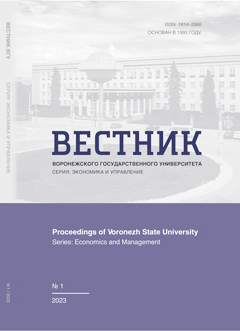ЭВОЛЮЦИЯ КОНЦЕПЦИИ БЛИЗОСТИ И АКТУАЛЬНАЯ КЛАСТЕРНАЯ ПОЛИТИКА
Аннотация
Рассматривается современный этап эволюции теоретических представлений о роли близости в создании положительных эффектов кластеризации, актуальные принципы кластерной политики и характеристики конкурентоспособности кластеров. Преимущества географической близости и экономическая роль кластеров хорошо изучены и определены. Однако сегодня географическая близость рассматривается как недостаточное условие для достижения положительных эффектов кластеризации, как следствие динамики делового окружения, сокращения жизненного цикла товаров и услуг, роста объема знаний и компетенций, все чаще недоступных на локальном уровне. Развиваются новые, непространственные формы измерения близости. Формулируются новые принципы кластерной политики и характеристики конкурентоспособности кластеров, представленные в данной статье на основе современного опыта ЕС. Акцент сделан на инновационных кластерах и территориальном развитии. Подчеркнута роль предпринимательских фирм как двигателей конкурентной эволюции кластеров, значение растущего числа межрегиональных и международных связей участников кластеров, а также новых форм кросс-кластерного сотрудничества.
Metrics
Литература
2. Rosenfeld S. Bringing business clusters into the mainstream of economic development / S. Rosenfeld // European Planning Studies. – 1997. – Vol. 5 (1). – P. 3–23.
3. Biggiero L. Does geographical proximity enhance knowledge exchange? The case of the aerospace industrial cluster of Centre Italy / L. Biggiero, A. Sammarra // International journal of technology transfer and commercialization. – 2010. – Vol. 9 (4) – P. 283–305.
4. Breschi S. Clusters, networks, and innovation : Research results and new directions / S. Breschi, F. Malerba // Clusters, Networks & Innovation. Oxford University Press Inc. – New York. – 2005. – P. 1–28.
5. Markusen A. Sticky places in slippery spaceA typology of industrial districts / A. Markusen // Economic Geography. – 1996. – Vol. 72 (3). – P. 293–313.
6. Morrison A. Gatekeepers of knowledge within industrial districts : Who they are, how they interactA. Morrison // Regional Studies. – 2008. – Vol. 42 (6). – P. 817–835.
7. Moodysson J. Knowledge collaboration and proximity : the spatial organization of biotech innovation projects / J. Moodysson, O. Jonsson // European Urban and Regional Studies. – 2007. – Vol. 14 (2). – P. 115–131.
8. Herrmann A. M. Beyond Regional Clusters : On the Importance of Geographical Proximity for R&D Collaborations in a Global Economy – the Case of the Flemish Biotech Sector / A. M. Herrmann, J. L. Taks, E. Moors // Industry and innovation. – 2012. – Vol. 19 (6) – P. 499–516.
9. Halder G. Local upgrading strategies in response to global challenges : The surgical instrument cluster of Tuttlingen / G. Halder // In Schmitz H. (ed.). Local Enterprises in the Global Economy : Issues of Governance and Upgrading. – Cheltenham : Edward Elgar. – 2004. – P. 200–232.
10. Torre A. On the Role Played by Temporary Geographical Proximity in Knowledge Transmission / A. Torre // Regional Studies. – 2008. – Vol. 42 (2). – P. 869–889.
11. Bathelt H. Between luminaries and meat grinders : international trade fairs as temporary clusters / H. Bathelt, N. Schuldt // Regional Studies. – 2008. – Vol. 42 (6). – P. 853–868.
12. Cooke P. Regional innovation systems : institutional and organisational dimensions / P. Cooke, G. Uranga, G. Etxebarria // Research Policy. – 1997. – Vol. 26 (4–5). – P. 475–491.
13. Gallaud D. Geographical Proximity and Circulation of Knowledge through Inter-firm Cooperation / D. Gallaud, A. Torre // Regional Studies. – 2005. – Vol. 39 (2). – P. 21–35.
14. Grossetti M. Where do social relations come from? A study of personal networks in the Toulouse area of France / M. Grossetti // Social Networks. – 2005. – No. 27. – P. 289–300.
15. Torre A. Proximity and localization / A. Torre, A. Rallet // Regional Studies. – 2005. – Vol. 39 (1). – P. 47–60.
16. Boschma R. Proximity and Innovation : A Critical Assessment / R. Boschma // Regional Studies. – 2005. – Vol. 39 (1). – P. 61–74.
17. Arend R. J. Defending against rival innovation / R. J. Arend // Small Business Economics. – 2009. – No. 33. – P. 189–206.
18. Cooke P. Regional knowledge capabilities and open innovation : Regional innovation systems and clusters in the asymmetric knowledge economy / P. Cooke // Clusters, Networks & Innovation. Oxford University Press Inc. – New York. – 2005. – P. 80–112.
19. Nooteboom B. Innovation, learning and cluster dynamics / B. Nooteboom // In Cooke P., Martin R. (eds.). Clusters and Regional Development. Critical reflections and explorations. Regional Studies Association. Routledge. – New York. – 2006. – P. 137–163.
20. Lagendijk A. Proximity, Knowledge and Innovation in Peripheral Regions. On the Intersection between Geographical and Organizational Proximity / A. Lagendijk, A. Lorentzen // European Planning Studies. – 2007. – No. 4. – P. 457–466.
21. Carrincazeaux C. Clusters, proximities and networks / C. Carrincazeaux, M. Grossetti, D. Talbot // Special Issue of European Planning Studies. – 2008. – Vol. 16 (5). –P. 613–621.
22. De Marchi V. Industrial districts and the collapse of the Marshallian model : Looking at the Italian experienceV. De Marchi, R. Grandinetti // Competition & Change. – 2014. – Vol. 18 (1). – P. 70–87.
23. Lorentzen A. Knowledge networks in local and global space / A. Lorentzen // Entrepreneurship & Regional Development. – 2008. – No. 20. – P. 533–545.
24. Torre A. Proximity relations at the heart of territorial development processes / A. Torre // In Torre A., Wallet F. (eds.). Regional development and proximity relations. New Horizons in regional Science. – Edward Elgar. – London. –
2014. – 375 p.
25. Ramírez-Pasillas M. International trade fairs as amplifiers of permanent and temporary proximities in clusters / M. Ramírez-Pasillas // Entrepreneurship and Regional Development. – 2010. – Vol. 22 (2). – P. 155–187.
26. Welck H. Concept of Meta-Cluster in the Alpine Space / H. Welck. – URL.























